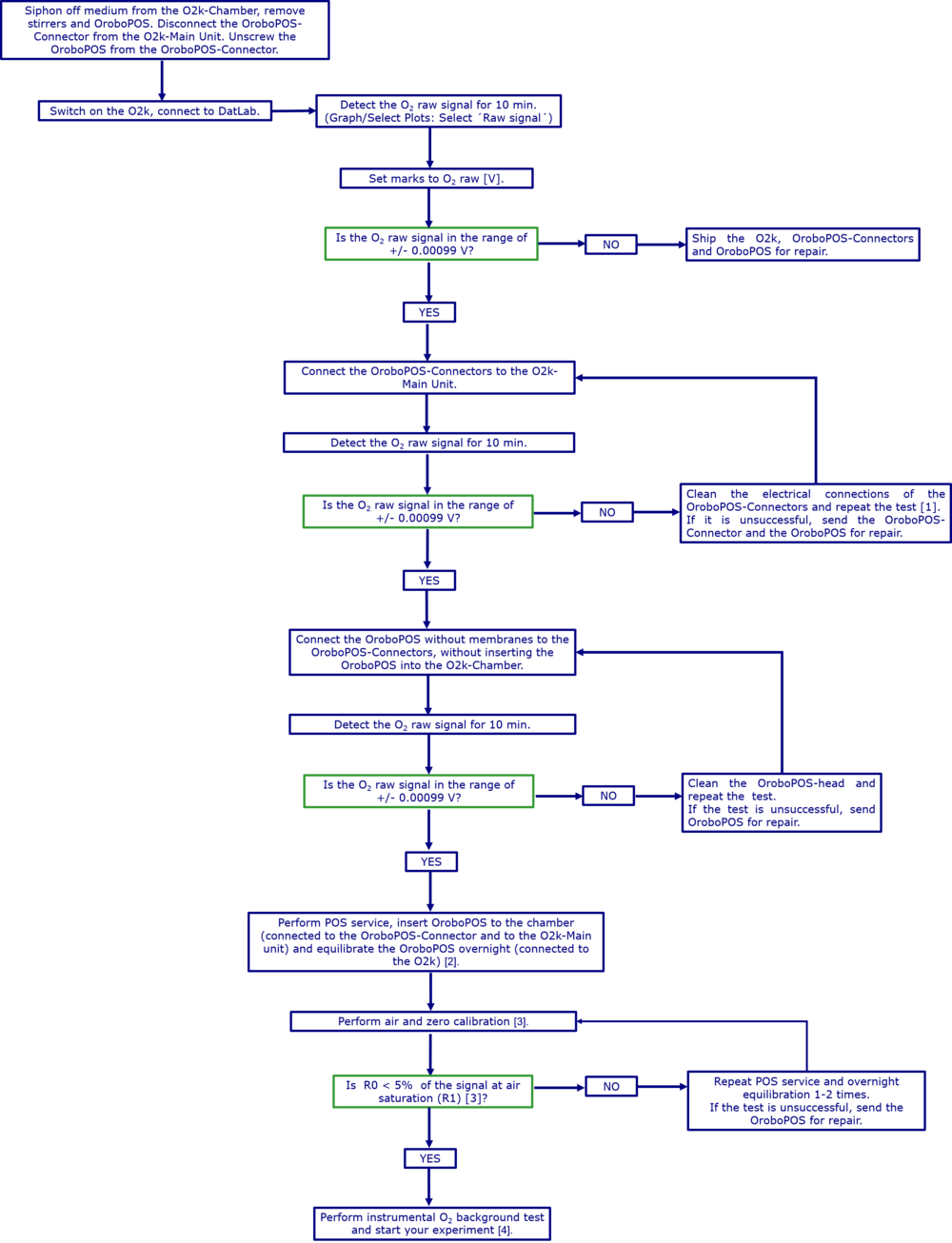Description
Zero calibration is together with air calibration one of the two steps of the OroboPOS calibration. It is performed in the closed chamber after all the oxygen has been removed by the addition of dithionite or by respiration of imt or cells. Any incubation medium can be used for zero calibration with dithionite or sample. Unlike air calibration it is not necessary to perform a zero calibration each day.
Abbreviation: R0
Reference: MiPNet06.03 POS-calibration-SOP, O2 calibration - DatLab
MitoPedia O2k and high-resolution respirometry:
O2k-Open Support
When
- A zero calibration should be performed
- From time to time as a record of instrumental performance: use the DatLab-Analysis template.
- A zero calibration should be performed
- A zero calibration has to be performed
- When measurements are performed at low oxygen (<10 µM).
- Bracketing zero calibrations are required when measurements are performed near the limit of detection at oxygen concentrations close to 5 nM (0.005 µM).
- When a new or serviced OroboPOS is used for the first time.
- When a new membrane was applied to the sensor.
- When the gain is changed.
- When a new OroboPOS-Connector is used.
Incubation medium for zero O2 calibration with dithionite
- Any incubation medium can be used for zero calibration with dithionite. MiR05 or a highly concentrated phosphate buffer are needed for measurement of instrumental background oxygen flux when using dithionite, to avoid secondary oxygen consuming reactions after a step titration of dithionite. For zero calibration, however, an excess dithionite concentration is applied which consumes all dissolved oxygen in the medium, and secondary reactions are not an issue.
Zero current
- Each polarographic oxygen sensor has a zero current, i.e., a current [µA] that flows even at an oxygen concentration of zero, which is converted into a voltage [V] as the raw signal. This zero oxygen signal is taken into account by the zero calibration and can be expressed as % of the raw signal at air saturation. New OroboPOS have a zero signal below 2 % of the signal at air saturation. For accurate calibration, the zero signal must be stable, which may be the case for zero currents up to 5 % of the signal at air saturation. The stability of the zero current can be assessed by keeping track of calibration values using the "O2k-Calibration-list.xls" template.
Troubleshooting
High or unstable zero current
- A high or unstable zero current is caused either by the O2k-Main Unit, by the OroboPOS, by the OroboPOS-Connector or by a bad connection between those parts.
- In order to localize the problem, the following test should be performed:

- Note: Before sending us the O2k or any spare components, please contact us via our O2k-Open Support system: O2k-Open Support
- Example:


- Figure 1. High zero current test. Upper panel: Zero current is in the range of ±0.00099 V. Lower panel: Zero current is higher than 0.00099 V when the OroboPOS-Connector is connected to the O2k-Main unit and when the OroboPOS is connected to the OroboPOS-Connector, which means that both the OroboPOS-Connector and OroboPOS have electrical problems. First, the OroboPOS-Connector and the POS were disassembled and disconnected from the main unit. Second, the OroboPOS-Connector was connected to the O2k-Main unit without the OroboPOS. Third, the OroboPOS was connected to the OroboPOS-Connector without membranes. After each step, the O2 raw signal [V] was recorded for 10 min. The marks were set to the O2 raw signal [V] to evaluate the zero current.
- Example:
O2k-Manual
- » MiPNet06.03 POS-calibration-SOP
- » Previous version: MiPNet19.18D O2k-Series G and DatLab 6: Calibration
Keywords: Oxygen signal
- Bioblast links: Oxygen signal - >>>>>>> - Click on [Expand] or [Collapse] - >>>>>>>
- Specific
- O2k-Procedures
- MiPNet O2k-Procedures
- General
- » Oxygen, dioxygen, O2
- » Oxygen calibration - DatLab
- » Oxygen solubility
- » Oxygen solubility factor
- » Oxygen pressure
- » Concentration
- » Activity
- » Pressure - Pascal
- » Barometric pressure
- » High-resolution respirometry
- » OroboPOS
- » Polarographic oxygen sensor
- » MitoFit Quality Control System
- » Sensitivity
- General
- Other keyword lists
MitoPedia methods: Respirometry
MitoPedia O2k and high-resolution respirometry:
DatLab

